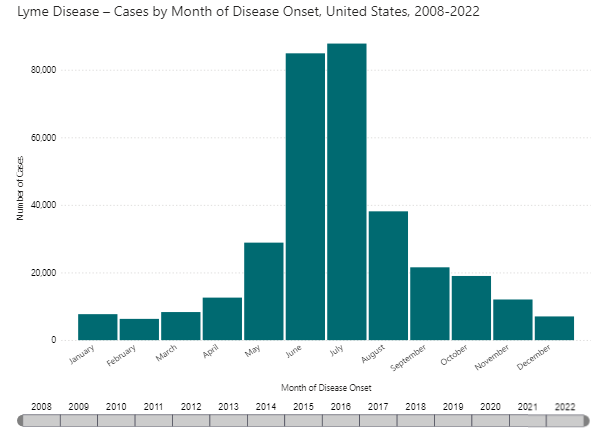Prevention of Lyme Disease
New cases of Lyme disease have increased to close to 500,000 annually in the US. It is important to know how to reduce your risk by taking preventative steps to protect you and your loved ones.
The deer ticks that transmit Lyme disease are very small (the size of a pinhead) and difficult to see. It is important that you educate yourself with the following pro-active preventative measures to minimize your Lyme disease risk.
- When outside wear protective clothing treated with tick pesticides such as permethrin and treat your skin with a tick repellent such as deet. Use this EPA tool to help find the repellent that is right for you.
- Enjoy the outdoors more safely by staying on marked trails and out of tall grass and leaf litter.
- Create a tick-free zone around your house.
- Perform daily tick checks especially after coming in from the out of doors and showering.
- Remove ticks once found immediately by grasping with a tweezer and pulling them straight off the skin without twisting. Pull by the head, the part closest to the body, not the belly. Wash the bite site with soap and water and apply rubbing alcohol or antiseptic. See more details on Tick Removal below.
- Put clothes in dryer on high heat for 15 minutes after being outside
- If rash appears, take a photo, write down the date, and track your symptoms. Call or visit your doctor immediately.
- Click here for additional prevention information.

ALTHOUGH GREATER IN SUMMER MONTHS, THE RISK FOR LYME DISEASE IS YEAR-ROUND
Removing Ticks
What to do after a tick bite
Tips for Removing the Tick
You can’t get sick from a tick that is crawling on you but has not yet attached. Ticks must bite you to spread their germs. It the tick is attached it will be hard to pull off.
Tick attachment time is important. Removing ticks as soon as possible reduces the risk of infection. If you or a loved one is bitten, remove the tick promptly. Here’s how:
- Grasp the tick’s mouthparts against the skin, using pointed tweezers.
- Be patient; the long mouthpart is covered with barbs, so removing it can be difficult and time consuming.
- Pull steadily without twisting until you can ease the tick head straight out of the skin.
- DO NOT pull back sharply; this may tear the mouthparts from the body of the tick and leave them embedded in the skin.
- If this happens, don’t panic! Embedded mouthparts do not transmit Lyme disease.
- DO NOT squeeze or crush the body of the tick; this may force infected body fluids from the tick belly into the skin.
- DO NOT apply substances such as petroleum jelly, nail polish, or a lighted match to the tick while it is attached. They may agitate the tick and force more infected fluid into the skin.
- Once you have removed the tick, wash the wound site and your hands with soap and water, and apply rubbing alcohol or antiseptic to the site.
- If you have found a tick on you, it’s a sign there may be others. Do a careful tick check of yourself and family.
- Observe the bite site over the next two weeks for any signs of an expanding red rash or flu-like symptoms.
- Consult with your PCP about potentially sending your tick to a lab such as TickCheck or TickEncounter to be tested for pathogens.
Other Health and Wellness Tips
- A good night sleep, ideally 8 hours at a consistent timeframe
- Regular exercise, aiming for 30 minutes per day if able
- A balanced nutrient-rich diet, ideally organic, that includes 4-9 servings of fruits and vegetables and 8 glasses of water per day
- Minimize processed foods, sugars, refined flour, saturated fats, and alcohol. Reduce caffeine. Be aware of the possibility of food sensitivities including gluten, dairy, or alpha gal meat allergy.
- Investigate your living environment if you suspect mold, dust, or other allergens.
- Good support systems of friends, family, community, and a professional counselor if needed
- Regular mindfulness meditation, restorative yoga, and spiritual practice
- Practices that promote joy, positive thinking, self-compassion, and hope
- Vitamins and supplements
- Integrative/complementary practioner support if needed



